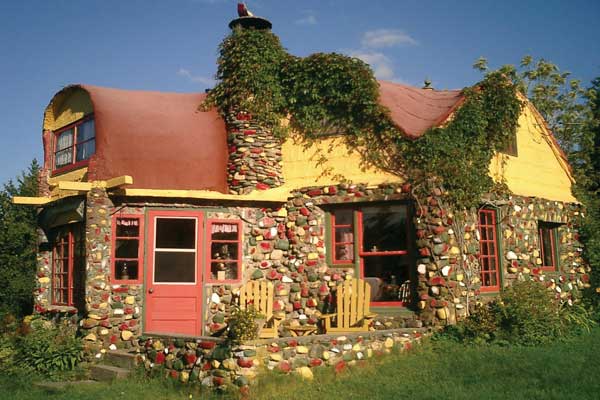There's a story behind four colourful cottages at Huntington Point, NS. It's the story of an artist, a concrete visionary and man of the people. It's a romance, a comedy, a social history and at times even a tragedy. And thanks to a handful of remarkable people, it has a happy ending.
The story's protagonist, Charlie Macdonald, was born in Steam Mill, NS, in 1874. He left school at 15, trained as a coffin maker and a wheelwright, and then worked as a ship's carpenter, travelling to New York, Brazil, Russia, Europe and Egypt. But Charlie returned to Nova Scotia in 1912, maintaining that it was the most beautiful place on Earth.
Throughout Charlie's life he painted the land and seascapes he saw around him. He married Mabel Meisner from Chipman Brook, and spent 40 years pioneering the applications of concrete. A socialist at heart, Charlie built a cement factory in Centreville with the workers in mind, giving them the company upon his retirement.
Charlie believed in concrete at a time when wood was the building material of choice, and he used it to build his own home, in Centreville. Inside he experimented with concrete bookshelves, a concrete umbrella stand, and a surprisingly smooth concrete bathtub. Then he turned his attention outside: he made a concrete bed of roses, a sculpture garden and a number of cement animals. His lifelike cement deer are said to have fooled at least one real deer and a dog-as well as the occasional hunter.

During the Great Depression, Charlie built five fanciful concrete cottages at Huntington Point. He owned the land, and used his personal savings to finance this make-work project for the employees of his concrete plant. Unrestrained by blueprints, Charlie and his men created the unique structures from iron, driftwood and stone as well as concrete.
The cottages were known by the colour of their concrete roofs, by the families who owned them or simply by their shape. The Blue Cottage, the Green Cottage, the Spencer/Jefferson Cottage and the Macdonald Cottage still exist today. Only the little Teapot Cottage is gone.
The doomed Teapot Cottage sat directly on the beach. It was totally round, with the chimney constructed to look like a spout. Everyone loved it, especially honeymooners, and children were warned to leave them alone. Well, almost everyone loved it. In 1982, its owners had it bulldozed in favour of building a standard bungalow, and pushed the debris into the Bay of Fundy.
"Charlie would have turned over in his grave if he knew what happened to the Teapot," says Harley Hazelwood, who built his cottage just down the beach on land that he purchased from Charlie more than 50 years ago.
Verna Hood cried when she heard the news. Her parents once owned the Green Cottage, and she and her sister, Pauline Harris, spent many summers there.
"It was a very sad day for us," she says. "It was part of our childhood."
Then in 1996, Kentville resident Martha Crosbie heard that Charlie's Centreville house was up for sale, and feared it might go the way of the Teapot. She found some investors, secured a bank loan and formed the Charles Macdonald House of Centreville Society. The non-profit group bought Charlie's house and operates it today as a museum.
A few years later the society also purchased the Blue Cottage. Like Charlie's house, it's now a registered heritage property. The cottage features a concrete staircase, two concrete fireplaces and a concrete balcony and is rented out for $100/weekend.
"But it's not the Holiday Inn," warns society president Kevin West. "It's a funky, rough camping experience."
The three other cottages are privately owned. They all feature brightly painted beach-stone chimneys and oversized fireplaces built for beach wood. The owners of the Spencer/Jefferson Cottage have replaced the leaky concrete roof and added a few rooms, but cherish the rock-framed mural that Charlie painted above the fireplace. Charlie's own cottage was built last. Completed in 1938, it has remained in the Macdonald family.
Mabel spent summers there alone after Charlie died in 1967. She would bake for the neighbourhood children and play 45s with their parents. Harley Hazelwood remembers the time that Mabel decided to tar the roof. Although well in her 80s, she climbed up a decrepit ladder that Charlie had made from beach wood. A rung snapped and she fell, injuring her leg. Mabel repaired the ladder and tarred the roof before driving herself to the hospital.
"That was Mabel," says Gary Skinner, grandson of Roscoe Filmore, Charlie's neighbour and fellow socialist.
Gary's family lived with his grandparents, beside the Macdonalds, until Charlie loaned his father the money to buy their own house. He remembers their generosity and jokes that Mabel was twice as tall as Charlie.
"Well, maybe not twice as tall, but she was over six feet," he says, "and Charlie was only 5'2"."
Charlie may have been small in stature but he had a big heart, and his big heart found a match in Mabel. She was a kind, hard-working woman, an accomplished rug-hooker and an excellent cook, which was put to good use when she entertained the Good Neighbour Club. It was a heady, innocent time-a time of long days, card games, bonfires and political idealism.
Even Charlie's political beliefs had an innocent quality. He believed that society was obligated to help everyone-as with a socialist state-but in the imperfect world of capitalism, he would do his part as an individual to help people.
"And Charlie helped a good many people," says Verna Hood. "If people didn't like Charlie's politics, they ignored them."
While social justice was central to his politics, Charlie's paintings focused on natural beauty. His vibrant depictions of rural Nova Scotia are now valuable, although Charlie never took a nickel for his artwork.
Recently, 90 of his paintings were offered for sale to the Concrete House museum. The price was far beyond the means of the organization, but Harley Hazelwood stepped up. He bought the paintings and has loaned them to the museum. Harley's wife passed away a few years ago and he plans to donate the entire collection in her name.
It's clear that Harley misses his wife. He misses Charlie as well.
"He loved to talk," says Harley. "It's too bad you never met him."
Although Charlie has been gone for nearly 40 years, his story continues through the memories of people like Harley, Verna and Gary; in the ongoing efforts of people like Martha and Kevin. And through the colourful concrete cottages tucked away at the end of a gravel road, shining bright in the Fundy fog.
